#Eoraptor lunensis
Text

"What is to come"
(image id is both in the alt text and below the read more- I put it under one because it's incredibly long)
And so there we have it, the 200+ followers artpiece that I have been working on for several days, if I had to guess I'd say it took 25 or so hours over eleven days. Honestly it's so surreal to me that I'm here with over 200 followers (260 as of typing this- yes, I procrastinated on this), especially when I only hit 100 followers in February. It's genuinely really nice to know that people are actually interested in my art (before anyone brings up spam bots- I know there are a few of them amongst my followers but I've checked most of them and I am 100% confident that over 200 of them are real). I don't really have much else to say really- I'm just grateful to have the support. Thanks y'all :).
[Image id: a large, lineless digital drawing of several dinosaurs. It is nighttime. At the bottom of the piece, a lone Eoraptor lunensis is walking across the floodplains- both the ground and the Eoraptor are just silhouettes, the early dinosaur has been given protofeathers. The full moon is shining, it's size is exaggerated for artistic affect. Behind the moon, the heads of sixteen different dinosaurs can be seen (listed left to right, bottom to top) Row 1- Thecodontosaurus antiquus (small sauropodomorph with light brown protofeathers, near-white undersides, straight stripes that are moderately darker than the base colour and vibrant green eyes), Coelophysis bauri (small early theropod with a long and narrow skull, its protofeathers are golden and black. A soft orange stripe runs across the back of its head, it has warm brown eyes. Row 2- Plateosaurus trossingensis (long-necked sauropodomorph, it has reddish-brown scales, light undersides, triangular stripes running down it's spine that get bigger the further down they get and pale yellow eyes), Heterodontosaurus tuckii (small ornithopod with a hooked grey beak. It has spiky green feathers, a lighter chest and a darker stripe running along its head and back, there are three small spots on its face, two behind the eye and one infront of it, it's eyes are bright yellow). Row 3- Megalosaurus bucklandii (medium-sized theropod with warm brown feathers, lighter undersides, dark spots and bright yellow eyes, there are several scars on its face), Brachiosaurus altithorax (greenish-grey true sauropod with lighter undersides, a dark pink patch on its throat, dark desaturated brown eyes and a few small scars on its neck), Archaeopteryx (early toothed bird with a black head, white neck and bright yellow eyes). Row 4- Hylaeosaurus armatus (pale brown ankylosaur with lighter undersides and vibrant green eyes), Velociraptor mongoliensis (dromaeosaur with light brown feathers, a lighter chest, a black stripe near its eye and light green eyes), Sinosauropteryx prima (small compsognathid theropod with ginger protofeathers, an off white mask and undersides and pale yellow eyes), Iguanodon bernissartensis (large greenish-grey ornithopod with a slightly darker back, pale undersides, a grey beak, and yellow eyes). Row 5- Matuku otagoense (heron with medium grey feathers and a small crest. A red stripe runs from just behind its nostrils to about a third of the way down its neck. Its undersides are white, its beak is grey and its eyes are brown), Triceratops prorsus (three-horned ceratopsian with grey-brown scales, lighter undersides, two triangular stripes between it's brow and nasal horns, reddish-orange diamond-like stripes on its frill, a hooked grey beak and golden eyes. Its brow horns curve forward at the base. Row 6- North Island brown kiwi (plump brown bird with a long pale beak, whiskers and black eyes, its nostrils are at the tip of its bill, and unlike the other dinosaurs in the sky part of its body below the neck is visible), male house sparrow (small redish-brown and grey bird with a black bib below it's bill), it has brown eyes and a dark grey bill. Row 7- rock dove (grey bird with iridescent green feathers scattered across its neck, a dark grey beak, and warm brown eyes). end id]
#art#my art#digital art#paleoart#dinosaurs#birds#eoraptor#thecodontosaurus#coelophysis#plateosaurus#megalosaurus#brachiosaurus#archaeopteryx#hylaeosaurus#velociraptor#sinosauropteryx#iguanodon#matuku#triceratops#north island brown kiwi#house sparrow#rock dove
3K notes
·
View notes
Text

Eoraptor lunensis, from the Triassic, featuring some plants that might have been found during that time period. Eoraptor means "dawn thief." It's a cool early sauropodomorph. <3
4 notes
·
View notes
Note
hiii! did yuo know that argentina is one of the most important countries in terms of dinosaur paleontology, with a total of 170 valid dinosaur species as well as the largest known dinosaur (Argentinosaurus huinculensis) and some of the earliest known dinosaurs (e.g. Eoraptor lunensis, Eocursor parvus)?
(i saw that you were mutuals with one of mine so i thought i would say hi :3)
hi!! :3
yeah i knew about the argentinosaurus :3
its my fav dinosaur!! :3
but i didnt know about all the others!! :3
very interesting, tysm!! :3
2 notes
·
View notes
Text


Drawing idea inspired by the eclipse.
I thought about drawing Helioceratops standing in front but it kind of didn't make sense since it's named after the sun.
So I sketched another idea with Eoraptor since it's specific name lunensis means "moon inhabitant" because of its place of discovery. Helioceratops quills being like the sun flares peaking out behind the moon.
2 notes
·
View notes
Text
sorry for not including any sauropods. as if its my fault
jokes. i had to choose between 12 of my faves and unfortunately no sauropods made the cut. (Eoraptor lunensis was close tho, it was either that or O. philoceratops and i only barely like the latter more)
also excluded was Archaeopteryx lithographica bc i had a feeling it would sweep simply by virtue of being the most famous dinosaur on the list by far
9 notes
·
View notes
Text







Eoraptor is a genus of basal sauropodomorph dinosaur, and one of the earliest known dinosaurs to exist, which lived throughout what is now South America during the Carnian stage of the Triassic Period some 231 to 228 mya. The first remains of Eoraptor consisting of a partial articulated skeleton were unearthed in 1991 from the Valle de la Luna and the Cancha de Bochas Member of the Ischigualasto Formation in Argentina, by paleontologist university of San Juan paleontologist Ricardo Martínez, during field work conducted by the University of Chicago and the University of San Juan. The specimen was then shipped to the Field Museum of Natural History in Chicago for preparation by William F. Simpson and Bob Masek. It was then described by Paul Sereno, Catherine Forster, Raymond R. Rogers, and Alfredo M. Monetta in 1993. Who named the animal Eoraptor lunensis meaning dawn plunderer from the Valley of the Moon. Said holotype was later returned to Argentina where it remains on display at the Museum of Natural Sciences. Today three mostly complete Eoraptor remains have been recovered along with other isolated elements such as teeth. Reaching around 3.3 to 5.7ft (1 to 1.7m) in length and 11 to 22lbs (5 to 10 kgs) in weight, eoraptor was quite small and lightly built compared especially compared to its titanic descendants the sauropods. It was a bipedal animal, capable surprising speed and agility, with flexible 5 fingered hands which sported 3 large claws likely used to help capture prey. Combined with its distinctive lightly built skull, these features caused scientists to first assign eoraptor as a theropod. However over time certain skeletal morphologies and its leaf shaped teeth lead it to reclassified as a sauropodomorph. In life eoraptor would have been an omnivore feeding upon ferns, cycads, seeds, horsetails, conifers, insects, fungi, and small vertebrates.
Art Used can be found at the following links:
#eoraptor#sauropod#dinosaur#sauropodomorph#triassic#pleistocene pride#pliestocene pride#mesozoic#Ischigualasto formation
1 note
·
View note
Text
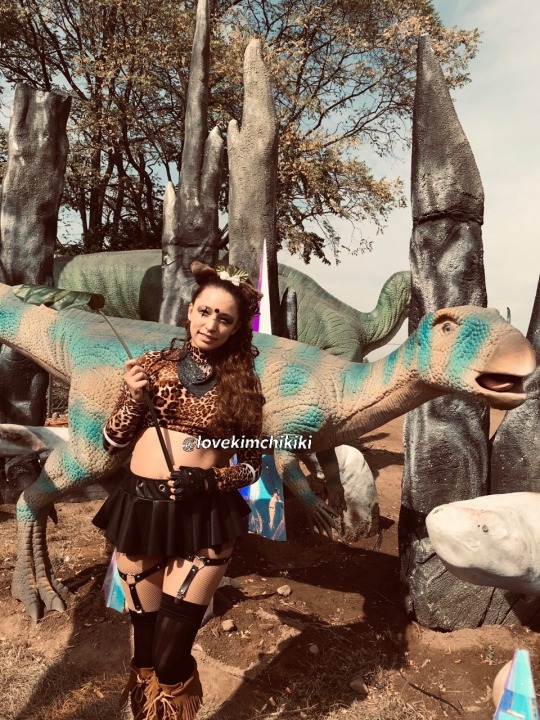

💚Over the last weekend, I spent my time at one of my favorite festivals ever! I absolutely loved this dubstep/trap filled weekend💚
I have stopped numerous times over this weekend to check on people and fanned them till they were good. The love and positive energy here is literally everything 💞
It was most definitely a getaway I needed, simply put, I needed a weekend to get lost to find myself all over again! 🦖
Lost Lands Music Festival thanks for one hell of a weekend! 3yrs OG and I’m absolutely in love with the progress of this wonderful festival. Down to the staffing, the new layouts, and the different artists each year! Excision and his team continue to out do themselves and grow! 👏🏻 much love for this festival!!!
(Featuring myself and my two favorite Dino’s!!)
#kawaii#cute#korean#lovekimchikiki#love.kimchi.kiki#dinosaur#triceratops#Eoraptor lunensis#Eoraptor#dinosaurs#lost lands#lost lands music festival#edm#dubstep#riddim#trap#excision#zeds dead#slander#flosstradamus#illenium#dubloadz#figure#protohype#music festival#lost lands 2019
6 notes
·
View notes
Text
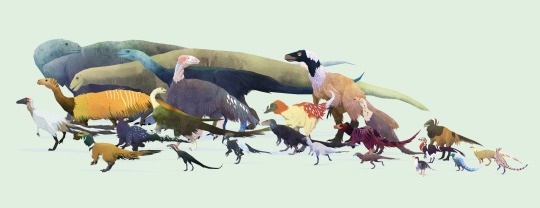
And now, time for an all dinosaurian Triassic fauna. From left to right: Coelophysis bauri, Blikanasaurus cromptoni, Ingentia prima, Lessemsaurus sauropoides, Unaysaurus tolentinoi, Chindesaurus bryansmalli, Efraasia minor, Coloradisaurus brevis, Camposaurus arizonensis, Eucnemesaurus fortis, Guaibasaurus candelariensis, Gnathovorax cabreirai, Sanjuansaurus gordilloi, Pampadromaeus barberenai, Herrerasaurus ischigualastensis, Staurikosaurus pricei, Eodromaeus murphi, Bagualosaurus agudoensis, Alwalkeria maleriensis, Panphagia protos, Chromogisaurus novasi, Eoraptor lunensis, Saturnalia tupiniquim and Buriolestes schultzi.
#palaeoblr#palaeontology#paleontology#paleoart#illustration#dinosaur#triassic#palaeoart#animals#mesozoic#dinosauria#dinosaurs
121 notes
·
View notes
Photo

Is a genus of small, lightly-built, basal saurischian dinosaur. One of the earliest-known dinosaurs, it lived approximately 231 to 228 million years ago, during the Late Triassic in Western Gondwana, in the region that is now northwestern Argentina. The type and only species, Eoraptor lunensis, was first described in 1993, and is known from several well-preserved skeletons. Eoraptor had heterodont dentition, which suggests that it was omnivorous.
Omnivore
Art (c) reneg661
2 notes
·
View notes
Photo

Eoraptor lunensis: the "dawn thief" of the Triassic, it may or may not have been the first dinosaur ever! In other news, I tried a new medium: alcohol-based markers.
#eoraptor#dinosaurs#triassic#copicmarkers#artists on tumblr#eoraptorlunensis#dawn#thief#raptor#desert
3 notes
·
View notes
Photo

I’m just going through and posting all my “Good” Paintings here to catch you all up
Name: Eoraptor Family
Animals shown: Eoraptor lunensis
Original Description: A happy family of E.lunensis is enjoying a nice Triassic morning in their nest. Contrary to most living examples, the female of the species is the more flashy, with bright teal quills coming from the head. Their baby is growing fast, eventually he will be out on his own, but for now, he enjoys the company.
This took me around 4 days to complete, and I am fairly proud of it. Expect artwork of this quality to be the norm around here from now on.
Things I’d change now: This I consider to be my breakthrough piece, my magnum opus if you will. I ‘might’ consider removing the scutate foot scales, but thats a variable that its highly contentious. Other than that, I really wouldn't change anything. Im pretty damn proud of this one, and still am.
Link to the original: https://kirbyniferousregret.deviantart.com/art/Eoraptor-Family-649682544
58 notes
·
View notes
Text
重新定義恐龍:是什麼特徵讓一種恐龍區別於另一種?
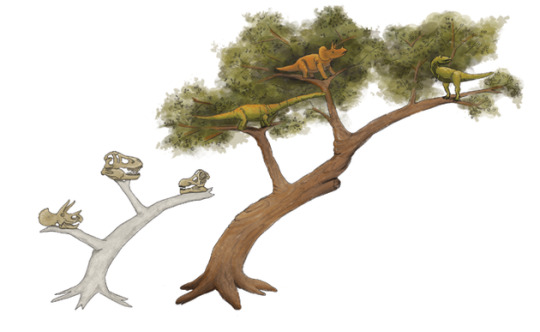
目前的恐龍演化樹從1887年開始使用,基本上是基於骨盆形態的差異。最近,科學家對這一分類方式的基礎提出了新的觀點
是什麼特徵讓一種恐龍區別於另一種恐龍?這個問題可能會讓很多人聯想到霸王龍巨大的下顎、角龍和劍龍身上獨特的角和板,以及蜥腳類恐龍及其近親的超大身軀。但對於古生物學家來說,要對不同的恐龍進行分類,關鍵在於這些動物的骨骼形態。
有了恐龍骨骼的形態學特徵和足夠的化石骨架知識,古生物學家可以大致確定恐龍標本在恐龍家族樹上的位置。然後,通過觀察其他特徵,特別是恐龍亞群共有的特徵,他們可以更詳細地找出這種動物的確切歸屬。
我們今天使用的恐龍分類系統首次發表於1887年。在研究了構成恐龍臀部的骨頭的朝向後,古生物學家哈里·西利(Harry Seeley)提出,根據骨盆的結構,所有的恐龍都可以歸為兩類。與所有四足動物一樣,恐龍骨盆由三塊骨頭組成:髂骨、坐骨和恥骨。西利發現,在某些物種,比如蜥腳類恐龍中,恥骨指向身體的前部,而對於其他物種,比如鴨嘴龍,恥骨則指向背部,與坐骨平行。西利將前一類恐龍稱為“蜥臀目”(Saurischia),因為這些動物的髖骨方向與蜥蜴的相似;後一類恐龍則被稱為“鳥臀目”(Ornithischia),因為它們的臀部結構與現代鳥類相似。在西利的分類中,這兩大分支中演化出了更特化的恐龍群體,包括演化出暴龍、馳龍和鳥類等類群的獸腳亞目恐龍。
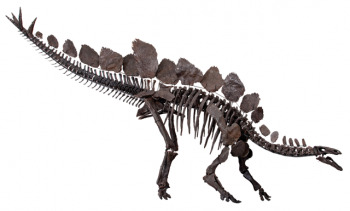
這張劍龍骨架圖顯示了其骨盆的後向恥骨。劍龍屬於鳥臀目,因為它們的骨盆結構與現代鳥類相似
從西利的時代開始,恐龍研究人員就一直把蜥臀目恐龍和鳥臀目恐龍區分開來。但是,在《自然》(Nature)雜誌2017年的一項研究中,由英國劍橋大學古生物學家馬修·巴倫(Matthew Baron)領導的團隊提出了對這種分類的徹底重組。巴倫和他的團隊建議,應該把鳥臀目和蜥臀目分類放在一邊,採用一種修正過的演化樹——對臀部骨骼結構的二分法並不能包含一切。這個新的分類把獸腳亞目恐龍和鳥臀目恐龍歸為一個新的類群,稱為“鳥腿目”(Ornithoscelida),而蜥腳類恐龍和艾雷拉龍(herrerasaurids)——在三疊紀滅絕的早期肉食性恐龍——仍然屬於蜥臀目(嚴格來說是蜥腳亞目)。
這樣的重組涉及恐龍演化樹底部附近的分支,代表著一次重大的改革,並且挑戰了建立在大約一個半世紀前研究基礎上的正統學說。新的分類有許多意義,比如表明肉食性恐龍獨立演化了至少兩次,分別是艾雷拉龍和獸腳亞目恐龍。由於這兩個群體之前都被認為是蜥臀目,因此傳統觀點認為,肉食性恐龍似乎只進化過一次。此外,羽毛曾經被認為存在於多種恐龍譜系中,但現在似乎只出現在獸腳亞目恐龍身上,而鳥類正是從獸腳亞目恐龍演化而來。此外,在長期使用的哈里·西利的演化樹中,我們並不清楚所有恐龍的最後共同祖先是蜥臀類還是鳥臀類,也不清楚從一種構造到另一種構造的演化過程可能發生了多少次。新的演化樹意味著,最早的恐龍具有似蜥蜴骨盆,而似鳥類骨盆的形態後來在多個“鳥腿目”支系中演化出來,特別是在鳥臀目和幾個獸腳亞目恐龍類群中。
然而,許多古生物學家並不准備接受這一經過修改的演化樹;這是一個艱難的命題,意味著我們對恐龍演化史的理解發生了巨大轉變。一些研究人員呼籲,我們應該謹慎行事,進行更多的研究。
一切都與骨骼有關

左邊是傳統的恐龍演化樹,根據骨盆形態的差異,將鳥臀目和蜥臀目分開。右邊是馬修·巴倫及其同事提出的新演化樹,其中鳥臀目與獸腳亞目形成了一個新的類群,叫做“鳥腿目”(Ornithoscelida
區分恐龍群體的關鍵是解剖數據,尤其是與骨骼相關的數據。然而,這些數據可能在某種程度上有些主觀,因此定義起來並不容易。當古生物學家試圖區分某一種恐龍或某個恐龍類群時,他需要藉助其他骨骼形態學的差異記錄。如果有足夠多的差異被記錄下來,就能描繪出關於恐龍如何演化出不同物種的畫面——從演化枝層面一直到單個物種。
從廣義上講,恐龍作為一個整體與其他爬行動物類群(如翼龍)的區別在於,它們的髖臼窩上有一個洞。雖然髖骨一直是研究的重點,但也有許多其他骨骼需要考慮,例如股骨和���齒。雖然像迷惑龍(Apatosaurus)這樣的蜥腳類恐龍有相對直的股骨,類似於支撐古希臘神廟的柱子,但像暴龍這樣的獸腳亞目恐龍的股骨則更多地呈弓形。與此同時,蜥腳類動物的牙齒形態也有所不同:一些具有鏟狀的牙齒,而另一些的牙齒則更像釘子。
這基本上就是巴倫和他的團隊在2017年的研究中所做的工作。他們建立了一個他們認為最能區分恐龍的形態學特徵數據集,包括顱骨上獨特的開口,以及不同肢體骨骼的形狀差異。他們總共觀察了74個不同恐龍類群的457個特徵,其中大部分數據來自之前發表的科學文獻。巴倫解釋稱,儘管他們並沒有打算從根本上重建恐龍的演化樹,但分析的結果使他們做到了這一點。
複雜的演化樹基礎
當你越接近恐龍演化樹的底部,也就是主要類群分化的地方,通過分析特徵來區分恐龍物種的做法就越棘手。已知的早期物種都有相似之處,古生物學家往往很難分辨誰是誰。這也是爭議的根源。對於巴倫團隊修改的恐龍演化樹,蘇格蘭愛丁堡大學的脊椎動物古生物學家史蒂夫·布魯薩特(Steve Brusatte)表示,這些早期的恐龍物種——稱為“恐龍形態類”(dinosauromorph) ——是解密恐龍演化樹基礎的關鍵。
在恐龍形態類中,一個基礎物種是晚三疊紀的月亮谷始盜龍(Eoraptor lunensis)。該物種的化石發現於阿根廷西北部的月亮谷,是一具近乎完整的骨架。始盜龍是一種兩足恐龍,生活在2.3億年前的岡瓦納超級大陸上。它的大小和狗差不多,生活在恐龍成為陸地頂級掠食者之前,後來才演化出今天我們所知的許多著名恐龍物種。

月亮谷始盜龍是一種早期恐龍,它可能是解決目前關於恐龍演化樹爭論的關鍵
巴倫表示,月亮谷始盜龍的前肢似乎適合抓握,而且它看起來是“完美、標準的基礎恐龍物種”。因為從形態上看,它可能是幾乎任何恐龍的祖先——這在確定哪些恐龍可能是它的直系後代時是個問題。巴倫說:“始盜龍就像是一場噩夢……”關於始盜龍到底是什麼,目前還眾說紛紜。
巴倫和他的同事認為,始盜龍適合抓握的前肢類似於後來獸腳亞目恐龍的前肢。其他研究人員,包括在20世紀90年代協助發現月亮谷始盜龍的芝加哥大學古生物學家保羅·塞里諾(Paul Sereno),根據拇指骨骼等特徵,認為它是蜥腳形亞目(Sauropodomorpha)的一員。蜥腳形亞目被認為是蜥腳類恐龍的祖先。塞里諾指出,月亮谷始盜龍的拇指骨頭彎曲,拇指的一側與地面接觸,這是後來蜥腳類恐龍的顯著特徵之一。
1961年,在南非侏羅紀早期的岩石中發現了另一種早期恐龍,塔克畸齒龍(Heterodontosaurus tucki)。古生物學家根據似鳥骨盆等特徵將其歸類為鳥臀目恐龍。然而,2017年新演化樹論文的共同作者、倫敦自然史博物館的恐龍專家保羅·巴雷特(Paul Barrett)表示,塔克畸齒龍“具有許多只有肉食性獸腳亞目恐龍才有的特徵”。塔克畸齒龍與獸腳亞目恐龍的相似特徵包括細長的肩胛骨、臀部前方用於肌肉附著的突出部分,以及像月亮谷始盜龍那樣適合抓握的前肢。這些共同點使巴倫、巴雷特和他們的同事第一次意識到,恐龍演化樹“發生了一些更加複雜的事情”。
巴雷特表示,塔克畸齒龍“是一種鳥臀目恐龍”,但基於新提出的恐龍演化樹,它似乎比原先想像的更接近獸腳亞目恐龍。
這些早期恐龍生活在演化樹的底部,對上層結構有著重要的意義。但是,早期恐龍的身份還存在著很多不確定性:它們是什麼?它們與後來的哪些恐龍關係最密切?這些都意味著它們在演化樹上的位置尚未確定。布魯薩特表示,這些早期恐龍“在演化樹上到處移動”,取決於你向誰提問。 “這些奇怪的物種中有一些具有不同群體的特徵組合。它們會造成麻煩,但也能讓我們看得更清楚。它們可以把不同類群聯繫起來,”他說道。
最重要的決定因素
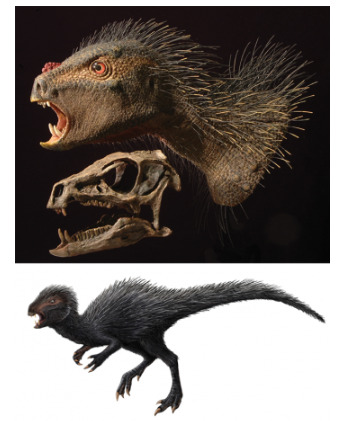
和始盜龍一樣,塔克畸齒龍也是近幾十年來發現的早期恐龍之一。這些新發現促使一些古生物學家重新思考恐龍的分類
不過,在做出任何定義之前,科學家必須就各種形態特徵(如拇指形狀)的重要性或相關程度達成一致意見,以便解釋不同物種之間的關係。這些特徵應該如何評估呢?塞里諾指出,這種評估十分主觀。
塞里諾表示,目前恐龍古生物學家整合和使用數據集的方式,以及他們建立演化樹的方式,都需要改變。他說:“你可以提出一個假說,然後忽略其他人以往觀察同一類群時所用的很大一部分數據。”
例如,當研究人員評估骨骼形態時,他們可能會將骨骼的某個特定部分描述為圓形或方形,這取決於研究人員自己。此外,如果某個研究者不能判斷形態學是圓的還是正方形的,他們可能會簡單地標註這個特徵“不存在”。但是,塞里諾解釋稱,“缺失”或“存在”與形態——感興趣的特徵——無關,因此將形狀描述為“缺失”掩蓋了該特徵在解釋演化關係方面的意義或相關性。
塞里諾認為,恐龍特徵的評估和數據集的使用都需要標準化,這是解決研究人員主觀性問題的唯一方法,“我們需要更多的規則”。
這些新規則將如何形成尚不清楚,但在標準化之前,當不同的研究人員進行分析時,將繼續出現不同的結果和不同的演化樹。例如,在2017年修改恐龍演化樹的提議之後,布魯薩特及其合作者研究了巴倫團隊使用的同一組特徵。他們仔細分析了研究中涉及的每一種形態特徵,並根據自己的專業知識對它們進行了重新解釋。最後,他們提出了支持傳統鳥臀目和蜥臀目分類的演化樹。布魯薩特說,主觀性就是“這場‘遊戲’的本質”。
古生物學的很多內容都來自主觀的描述和假設,比如始盜龍的“抓握前肢”與後來的獸腳亞目恐龍或蜥腳類恐龍之間到底有多大的相似性古生物學的很多內容都來自主觀的描述和假設,比如始盜龍的“抓握前肢”與後來的獸腳亞目恐龍或蜥腳類恐龍之間到底有多大的相似性
不過,這場爭論所有的參與者似乎都同意,“我們真的需要更多的化石,尤其是來自恐龍演化樹底部附近的三疊紀恐龍新化石,這些化石有助於理清這些支系之間的關係,”布魯薩特說,“(這場爭論)揭示出,我們以往認為的定論實際上還是一個謎,而這個謎必須被解開。”
巴倫表示同意:“可能是兩三個發現造成了所有的不同。”
目前,我們還不清楚哪種版本的恐龍演化樹——傳統的還是修正的——更接近真相。與此同時,為了克服意見上的分歧,古生物學家需要建立一套用於分析化石的標準指標,“我們需要更多的合作,”巴倫說。 (任天)
.
from 重新定義恐龍:是什麼特徵讓一種恐龍區別於另一種?
via KKNEWS
0 notes
Photo

Eoraptor lunensis
#dinosaur#dinosaurart#paleoart#palaeoart#eoraptor#eoraptorlunensis#ck's art#ck's original art#not bestiary
59 notes
·
View notes
Photo

Hey look, it’s Eoraptor luniensis! Everyone’s favourite ... basal sauropodomorph? Basal saurischian? Basal theropod? It’s basal, whatever it is. The colour scheme for this guy is somewhat inspired by these Eoraptor from Dinosaur Revolution, but of course I added feathers. I seem to really like drawing dinosaurs with feathery neckbeards for some reason. I’m a little worried.
EDIT: So apparently the name is actually lunensis, without the extra ‘i’. My life up until now is a lie.
177 notes
·
View notes
Photo

Herrerasaurus ischigualastensis and Eoraptor lunensis at the North American Museum of Ancient Life. #paleontology #fossil #biology #zoology #science #usofscience #animals #animal #marinebiology #fossils #utah #saltlakecity #dinosaurs #dinosaur (at Museum of Ancient Life at Thanksgiving Point)
#paleontology#dinosaurs#zoology#marinebiology#utah#fossils#biology#science#animal#dinosaur#animals#saltlakecity#usofscience#fossil
27 notes
·
View notes
Text
تشارلز داروين، لستُ بصدد تعريف عنه وعن حياته ومكانته العلمية والطفرة التي أحدثها في علم الأحياء. ولكن في كتابة أصل الأنواع يبدأ فصل جديد من حياه الأنسان غير التي عاصرها من قبل معرفته بالنظرية. من أين أتي الأنسان؟ ما هو الانتخاب الطبيعي؟ كيف للتطور البيولوجي أن ينتج بشر؟ هل النظرية تضر بالأديان؟ ولماذا الخرافة التي ابتدعها رجال الدين في اختزالها بانها تقول بأن الأنسان في الأصل قرد؟ ولكي نجاوب أنفسنا على ذلك كله يجب أن تتجرد من عصباتك وأيدولوجياتك وتتعرف على شكل الكون منذ بدايته وعن العصور التي مر بها منذ الانفجار العظيم حتى لب النظرية (التطور).
وانا لستُ بصدد الدفاع عن عالم أحياء تفصلنا الأف السنين كما يفصلني العلم الذي يملكه والمعلومات الضئيلة التي أجمعتها خلال قراتي لأصل الأنواع وتاريخ العالم ونشأة الكون فما أنا ألا قارئ مبتدأ وقد يكون هذا شرحا بسيطا وعرضا لمن لا يهوي ولا يمتلك قوة المثابرة على القراءة والاطلاع، وربما يكون سببا في مزيد من الاطلاع على ذلك العلم وكتابة المزيد من السطور فيما بعد.
***
مقدمة لابد منها.
البداية: منذ قرابة 13.7 بليون عام بدون سبب يوضحه العلم حتى الأن، حدث الانفجار العظيم والذي من خلاله تشكل الكون. وكما تقول القاعدة: (حيثما تتواجد مادة، تتكون مادة جديدة. وحيث لا يوجد شيء فلن يتكون شيء.) وعلى هذا فتكون الطاقة المتولدة من الانفجار الذرات الأولي، ومع ارتفاع درجات الحرارة تتكون ذرات أخري. ومع اندماج الذرات الأولي بالأخرى ومع اندماجهم تشع الانفجارات من الطاقة لتعلن مولد النجوم الأولي التي مع مرور ملالين السنين ستتفجر بدورها باندماجها مع كافة الذرات المتواجدة، لتشع انفجارا اخر يسمي (المستعمرات العظمي) فيتم من خلاله تكوين عناصر مثل (اليورانيوم، الذهب، النحاس والحديد…) والتي هي بالطبع يتواجد منها في أجسادنا أي إنها السلف المباشر للكائنات الحية.
وبتوالي بلألين السنين يولد نجم الشمس ومن ثم تأخذ الأرض مكانها ككوكب وسط المجموعة الشمسية ومن بعدها تتشكل المجرات والمدارات ومن ثم يولد القمر أثر انفجار اخر ومع ظهوره يصبح للأرض شمسا وقمرا فينتج عن ذلك نظام الفصول ونظام الوقت.
وبمرور ملالين من السنوات وربما بلالين: وانخفاض درجات الحرارة على الأرض وهطول الأمطار تتكون بركا وانهار التي هي بالأحرى ستساهم في تكوين المحيطات. فيصبح للأرض شمسا وقمرا ومحيطات. وبظهور المحيطات تبدأ الأرض في التجهز لاستقبال السلف الأول. فبأسفل هذه المحيطات يبدأ التطور، فباندماج العناصر والذرات التي تكونت بفعل غبار النجوم تتشكل عناصر أخري هي الأساسية في تكوين جميع الأحياء (الحامض النووي).
وبمرور سنين وسنين، ملالين من السنين تمر والأرض تأخذ في تشكيل نفسها بفعل الطاقة المنبعثة من الانفجار العظيم. حتى تبدأ العصور التي ينتمي اليها أسلافنا الأوائل.
****
العصر الأيدياكاري (عصر الأيدياكونا) 635 مليون سنة.
في هذا العصر أخذت البكتريا في أخذ شكل واضح لتكوين كائنات أخري تتطور تالي حيوانات تحت سطح المحيط. كانت كائنات عضوية تتغذي على امتصاص العناصر الغذائية من المياه ومن الواضح من الحفريات التي وجدت إنها كانت لا تمتلك أمعاء هضمية وكان بعضها لا يتحرك ولا يوجد لها. أذن من الواضح إنها كانت كائنات رخوية ومن المرجح إنها اختفت مع الانفجار الكامبري، التي كانت هي سببا فيه بعد استخدامها للأكسجين والكربون العضوي بالاشتراك مع البكتريا والطحالب، فتكاثرت وشكلت الأشكال المختلفة حتى حدوث النسخة الحيوية من الانفجار العظيم. وانتهاء عصر الايدياكونا، ودخول عصر جديد إلى تاريخ كوكب الأرض.
أحفورة ديكينسونيا
Sklerite من نوع سبيكولا .
قرص برونزي يعلّم الطبقة السفلى في الصورة ، وهو يمثل نقطة لبدء العصر الإيدياكاري.
****
عصر كمبري (الانفجار الكامبري) 541 مليون سنة.
وعلى مدار من 20 إلى 30 عام تطورت الحياة الحيوانية تحت سطح المحيطات فتشكلت الأجساد السمكية وتشكلت العيون وتبينت الأضواء وتطورت أجسادهم
إلى شوكيات وظهر الفك وتكونت العظام فبدأ متطورا (عصر كمبري) بافتراس البقية من (عصر الأيدياكونا). ومع ظهور النباتات أصبحت تعوقهم أكثر حتى أكتمل تطورهم وقبل 400 مليون سنة حدثت الطفرة الأولي التي أدت إلى ظهور البشر علي الأرض. فتوجهت البرمائيات إلى البر. وبحدوث ذلك ينتهي (عصر كمبري) وتدخل الأرض في حقبة جديدة.
البيكايا من اوائل الحبليات في الكامبري الأوسط.
كانت الأنومالوكاريديديات من أوائل الحيوانات البحرية المفترسة بين مفصليات ذلك الوقت المختلفة.
****
العصر البرمي 298 مليون سنة.
بتوجه البرمائيات إلى البر يصبحون بذلك أسلاف البشر الأوائل. ولكن تبدأ الأزمة بكيفية حمل مياه المحيط ببيوضهم إلى اليابسة ولكن بمرور الزمن يتطور شكلا جديدا من البيض يتلأم مع اليابسة لليحافظ على رطوبته بالداخل وكان هذا بمثابة حمل المحيط إلى اليابسة وبه تم انفصالهم عن المحيط وكان هذا مؤشر بداية تحولهم إلى زواحف. وتزدهر الحياة في مستنقعات شاسعة. ولكن بعد مرور ملالين السنين يقوم نشاط بركاني ضخم يخنق الحياة على الأرض بثاني أكسيد الكربون لينقرض أكثر من 70% من جميع الأحياء على الأرض. لينتهي العصر البرمي ويبدأ عصر جديد بتواجد ضعيف لبعض الثدييات.
رسم تخيلي لحيوانات الإستمنوسوكوس والفانتوساوروس.
تيتانوفونوس وأوليموساوروس [بالإنجليزية] (منطقة الاورال)
****
ومن ثم (العصر الثلاثي) 252 مليون سنة. و (العصر الطباشيري) 145 مليون سنة.
وهي العصور التي عاشت فيها الديناصورات وتطورت فصائلهم المتعددة. وكانت تعيش فيها الثدييات الناجية من العصر البرمي باستحياء على الأطراف دون دور واضح وبتطور غير ملحوظ. ولكن على مشارف انتهاء العصر الطباشيري أًبحت الثدييات في نهج تطوري كبير والمعيشة وسط الديناصورات التي انقرضت بعد ذلك بفعل اصطدام كويكب بكوكب الأرض وانقراض كل مخلوق يزن أكثر من 50 طن وبانقراضهم أعطوا للثدييات فرصة النهوض مره أخري، فتطورت أجسامهم واعينهم بشكل خاص وأصبح أيديهم أكثر مرانة وأخذت شكل الخمس أصابع. فأصبح أسلاف البشر من الرئيسات جاهزين للظهور وبداية عصر جديد أخر للأرض.
Eoraptor lunensis (ديناصور) عصر ثلاثي
Henodus (Placodontia) عصر ثلاثي
Lariosaurus (Nothosauria) عصر ثلاثي
بعض أحفورات من حيوانات بحرية وحيوانات كانت تعيش على اليابسة خلال العصر الترياسي.
عصر طباشيري
****
50مليون سنة تمضي والأرض تنجرف الأن إلى قارات فاتخذت الأميركتان وأفريقيا شكلهم وتتثبت الساعة عند24 ساعة في اليوم، بينما الكوكب يزداد حرارة ولكن بمرور ملالين السنين ولاتزال الأرض تتشكل يحث خلل في المحيط فتؤشر الأرض لقدوم عصر جليدي يجبر الثدييات والحيوانات الموجودة على الأرض اللجوء للعيش في المناطق المدارية، شرق أفريقيا حيث مولد الأنسان الأول.
وبمرو ملالين اخر من السنين يظهر العشب والنبات بكثرة، بينما أسلاف البشر الرئيسات لازالت بأمان فوق الأشجار ولكن لوجود الكثير منهم وتناقص الموارد الغذائية، يهبطون إلى الأرض وأصبح عليهم من الأن فصاعدا أن يتكيفوا مع ظروف البيئة الجديدة التي من الصعب عليهم فيها السير على أربعة، فلتجنب المخاطر وبالتكيف مع العشب والنباتات الطولية يبدأ السير على أثنين ومن ثم تتحر أيديهم. وهذا هو التقدم الجذري نحو التطور الذي بدأ في شرق أفريقيا -كينيا-.
فيخطوا الأنسان البدائي أو شبيه الأنسان على الأرض الأن، المليئة بصخور متكونة من عدة عناصر ومع وجود المادة يمكن وجود كل شيء، ويبدأ عصر جديد تشكله الأيادي البشرية البدائية، ويتخذ الأنسان المعاصر شكله الكامل وتنخفض الحنجرة من مكانة العلوي قليلا لتنتج صوتا معقدا يملك الأنسان لغة، فيبدأ في التحرك بأيادي متحررة رشيقة وأدوات بسيطة ممتلكا لغة وعقل سوف يبدأ في التفكير حتى يكتشف النار وباكتشافها تصبح الدماغ في اخذ شكلها الجديد. ويبدأ العصر الحجري بتحقيق القفزة الثقافية الأولي (برموز على الحائط) تكشف ما كان يجول في عقولهم ويمر على أعينهم، وبتحركهم على الأرض وانحسارهم أثناء العصر الجليدي بين مكانين ومقابلته للعصر الجليدي بالتكيف أصبح الأنسان يحارب الانقراض كما يحارب من اجل البقاء…….
****
الأن يمكننا بسط قراتنا الأولية لنظرية التطور -أصل الأنواع- لداروين بشكل يسهل على القارئ العادي استيعابها دون النظر في أفكار لاهوتية ومقدسة، لان النظرية قائمة علي العلم ليس ألا ولا علاقة لها بالأديان لا من قريب ولا من بعيد.
وكما يقول الفيلسوف سيبنوزا: “أن الكتب السماوية المنزلة لا تفسر الأشياء بأسبابها الثانوية، لكنها تقصها وترويها بطريقة وأسلوب قوي متدفق للتأثير على الناس، ودفعهم إلى الأيمان والنسك والعبادة، وخاصة الفئة الجاهلة غير المتعلمة منهم. أن الكتاب المنزل لا يستهدف مخاطبة العقل وإقناعه، بل جذب الخيال والسيطرة عليه. ومن اجل ذلك يكثر فيه ذكر المعجزات وتكرار مظاهر الله.”
****
(1)
قراءة أولية لداروين تشارلز داروين، لستُ بصدد تعريف عنه وعن حياته ومكانته العلمية والطفرة التي أحدثها في علم الأحياء. ولكن في كتابة أصل الأنواع يبدأ فصل جديد من حياه الأنسان غير التي عاصرها من قبل معرفته بالنظرية.
0 notes